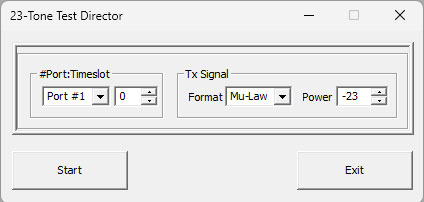23-Tone Test: Comprehensive Telecom Channel Analysis
Overview
The 23-Tone Test is a diagnostic tool used to evaluate the performance of communication channels. It consists of two main components: the Test Director (Tx) and the Test Responder (Rx). The Test Director transmits 23 distinct tones, while the Test Responder receives and analyzes these tones to assess signal integrity, frequency response, and channel impairments.
Main Features
- Comprehensive Signal Evaluation – Measures frequency response, distortion, and noise levels
- Two-Component System – Includes a transmitting (Tx) and receiving (Rx) unit for accurate performance analysis
- Configurable Signal Parameters – Allows selection of signal format, transmission power, and timeslot settings
- Digital Filtering – Enhances signal clarity and reduces noise using a D Filter
- Real-Time Monitoring – Continuously updates measurements to ensure communication reliability
23-Tone Test - Director (Tx)
The Test Director is responsible for generating and injecting 23 distinct test tones into the communication channel. These tones serve as a reference signal for evaluating parameters such as frequency response, distortion, and noise levels. By transmitting a well-defined set of tones, the Test Director ensures that the receiver has a known signal for comparison, enabling accurate performance analysis.
23-Tone Test - Responder (Rx)
The Test Responder is the receiving component that captures and analyzes the test tones after they pass through the communication channel. It compares the received tones with the originally transmitted signals to measure deviations caused by factors such as distortion, phase shifts, noise, and attenuation. The Test Responder helps identify transmission issues, ensuring that the communication system meets quality standards.

 Back to List of T1E1 Basic and Optional Applications Index Page
Back to List of T1E1 Basic and Optional Applications Index Page
